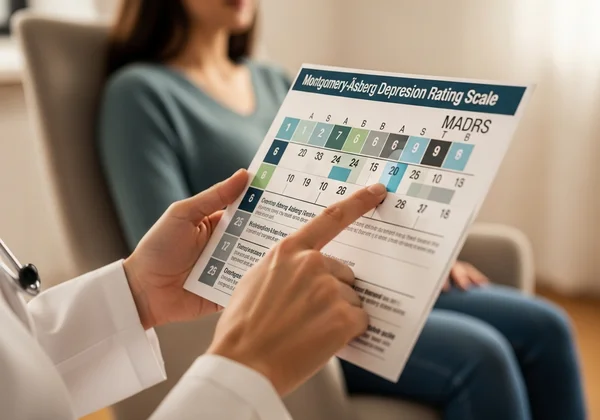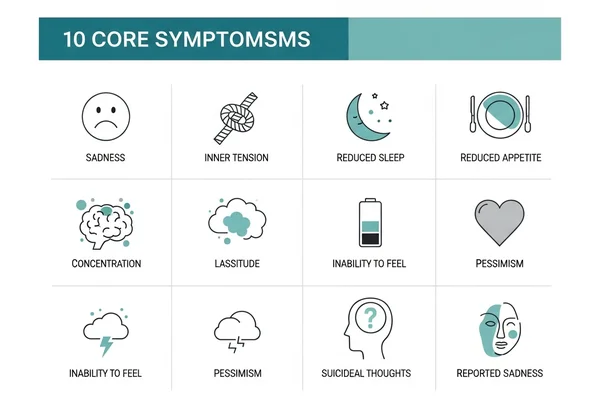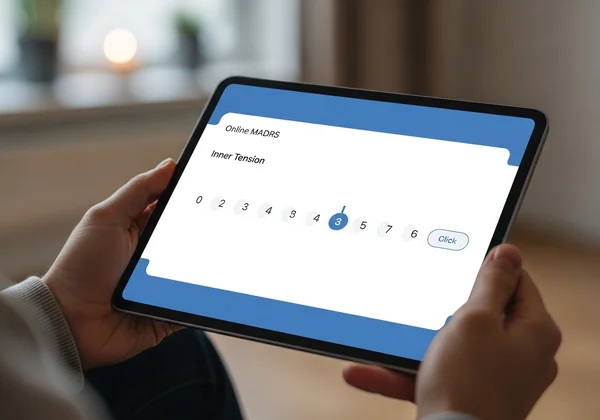What is the MADRS Scale? A Comprehensive Guide
Feeling overwhelmed by the challenge of measuring mental health? You're not alone. For clinicians and individuals alike, understanding the severity of depression requires a reliable tool. Enter the MADRS Scale—the clinical gold standard for assessing depressive symptoms. What is the MADRS scale and how can it bring clarity to your mental health journey? This guide will walk you through everything you need to know, from its expert-designed questions to how you can take a free assessment online right now.
This journey of understanding is a crucial first step. Whether you're a healthcare professional seeking an efficient tool, a student learning about clinical assessments, or an individual wanting to monitor your emotional well-being, the MADRS offers a structured and insightful framework. It moves beyond simple checklists to provide a nuanced view of the depressive experience, making it an invaluable resource for tracking progress and facilitating meaningful conversations about mental health.
Understanding the Montgomery-Åsberg Depression Rating Scale
The full name, the Montgomery-Åsberg Depression Rating Scale, might sound complex, but its purpose is straightforward: to offer a sensitive and detailed measurement of depression. Developed in 1979 by British and Swedish researchers, it was specifically designed to be more responsive to changes in a patient's condition during treatment compared to other scales at the time. This focus on sensitivity is what has cemented its reputation as a "gold standard" in clinical trials and psychiatric practice for decades.

It provides a common language for doctors, researchers, and patients to discuss and quantify symptoms that can often feel abstract and overwhelming. By breaking down the experience of depression into specific components, the scale helps create a clearer picture of an individual's state, guiding more effective and personalized care.
The History and Clinical Purpose of the MADRS
To appreciate the scale, it helps to understand its origins. Drs. Stuart Montgomery and Marie Åsberg created the scale to address a specific need in psychiatric research: a tool that could accurately detect changes in depression severity in response to antidepressants and other therapies. Older scales were sometimes not sensitive enough to capture subtle but significant improvements. The MADRS was built to be different, focusing on the core psychic and somatic symptoms of depression.
Its clinical purpose is twofold. First, it serves as a robust instrument for clinicians to assess the baseline severity of a patient's depression. Second, and perhaps more importantly, it is used to monitor changes over time, allowing doctors to see if a particular treatment plan is working. This dynamic tracking capability makes it an indispensable tool in both clinical practice and pharmaceutical research for evaluating treatment efficacy.
Who is the MADRS Assessment For?
The beauty of this assessment lies in its versatility. It's not just for one type of user; it serves a diverse audience with distinct needs:
- Clinical Professionals: Psychiatrists, psychologists, and general practitioners use the MADRS for initial diagnosis, treatment monitoring, and documenting patient progress. Its reliability makes it a trusted part of their clinical toolkit.
- Individuals and Patients: For those experiencing symptoms of depression, the scale offers a way to self-reflect and quantify their feelings. Taking a confidential MADRS test can provide a clear snapshot of their current state, empowering them to have more informed discussions with a healthcare provider.
- Researchers and Students: Academics and students in psychology, nursing, and medicine rely on the MADRS as a standard measure in studies. It ensures that data collected on depression is consistent and comparable across different research projects.
How Accurate is the MADRS Scale?
When it comes to mental health assessment, accuracy is paramount. So, how accurate is the MADRS? The scale is highly regarded for its psychometric properties, including excellent inter-rater reliability (meaning different clinicians will likely arrive at the same score for a patient) and validity (it measures what it claims to measure). Its particular strength is its sensitivity to change, which is why it's a preferred MADRS clinical tool for tracking recovery.
While no self-report tool can replace a full clinical evaluation, the digital version of the scale provides a highly reliable starting point. Our platform ensures the online test adheres strictly to the established clinical framework, so you can trust the score you receive as an accurate reflection based on the scale's methodology. This accuracy is fundamental to providing a trustworthy self-report.
A Breakdown of the 10 MADRS Scale Questions
The power of the MADRS Scale Questions lies in their focused and comprehensive nature. The test consists of 10 questions, each designed to evaluate a key symptom of depression. This structure ensures a thorough assessment without being overly burdensome for the user. Understanding these questions can demystify the assessment process and help you recognize the different facets of depression.
Each question is rated on a 7-point scale (0-6), where a higher score indicates greater severity for that particular symptom. This detailed scoring allows for a more nuanced final result than a simple "yes/no" format. Let's explore the core areas this powerful MADRS for depression tool examines.
The 10 Core Symptoms Assessed by MADRS
The scale covers a spectrum of emotional and physical symptoms. Here are the 10 core symptoms assessed by the scale, giving you insight into its depth:

- Apparent Sadness: An observer's impression of the individual's sadness, based on their expression and demeanor.
- Reported Sadness: The individual's own subjective experience of sadness, gloom, and despondency.
- Inner Tension: Feelings of ill-defined discomfort, irritability, and inner turmoil.
- Reduced Sleep: Difficulties with sleep patterns, whether it's trouble falling asleep, waking during the night, or waking too early.
- Reduced Appetite: A noticeable decrease in appetite compared to the individual's normal state.
- Concentration Difficulties: Trouble focusing, gathering thoughts, or making decisions.
- Lassitude: A pervasive sense of weariness, fatigue, or low energy levels.
- Inability to Feel (Anhedonia): A reduced interest in or enjoyment from activities that were once pleasurable.
- Pessimistic Thoughts: Preoccupations with feelings of guilt, worthlessness, or hopelessness about the future.
- Suicidal Thoughts: Thoughts about life not being worth living, ranging from fleeting ideas to concrete plans.
Understanding the MADRS Scoring System
The MADRS scoring system is what translates your answers into a meaningful result. Each of the 10 items is scored from 0 to 6, with specific descriptions guiding the rating at 2-point intervals (0, 2, 4, 6). The total score is calculated by summing the scores for all 10 items, resulting in a range from 0 to 60.
This total score provides a quantitative measure of depression severity. While the interpretation should always be done in consultation with a professional, general guidelines for MADRS score interpretation exist. The final number helps categorize the level of depression, which is the first step toward creating a plan for management or treatment. You can discover your results instantly after completing the test on our platform.
Take a Free and Confidential MADRS Online Test
Knowledge is power, and understanding where you stand is the first step toward taking control of your mental health. We believe everyone deserves access to high-quality assessment tools, which is why we offer a free and completely confidential MADRS online test. Our platform brings the clinical precision of the MADRS directly to you in an accessible, user-friendly format.

There is no need to wait for an appointment to get an initial sense of your symptoms. Our streamlined process allows you to answer the 10 questions and receive your score in minutes, providing immediate insight in a secure environment.
Why Take Your MADRS Assessment Here?
When you choose our online MADRS assessment, you are choosing a platform built on three core principles: accuracy, accessibility, and insight. We strictly adhere to the clinical standards of the Montgomery-Åsberg scale to ensure your score is reliable. The test is free, immediate, and available in over 15 languages.
What truly sets us apart is the option to unlock a personalized AI MADRS report. This unique feature goes beyond the score, providing a comprehensive analysis of your responses. It highlights your strengths, potential challenges, and offers actionable suggestions tailored to your unique situation. This transforms a simple score into a practical guide for self-improvement and professional consultation. Ready to see for yourself? Start My Free MADRS Assessment today.
A Note on Privacy and Professional Advice
Your trust is our top priority. We are committed to protecting your privacy and professional advice is something we deeply respect. All data you provide is handled with strict confidentiality and security. We will never share your personal information.
It is crucial to remember that this tool is for informational and monitoring purposes only. It is not a substitute for a professional diagnosis or medical advice. A MADRS score can be an incredibly helpful piece of information, but it should be discussed with a qualified healthcare provider, such as a doctor or therapist, who can provide a complete evaluation and guide you on the best next steps.
The Montgomery-Åsberg Depression Rating Scale is a globally trusted instrument for shedding light on the complexities of depression. By transforming abstract feelings into clear, quantitative data, it creates a solid foundation for dialogue and action—whether you're seeking personal insight or monitoring treatment in a professional capacity.
Your journey to clarity can begin today. Ready to take the first step?
Take our free MADRS assessment and get your confidential score in minutes.
Frequently Asked Questions About the MADRS Scale
What is considered a normal MADRS score?
While a definitive interpretation requires a clinical expert, scores are generally categorized as follows: 0-6 suggests no depression or being in remission; 7-19 indicates mild depression; 20-34 suggests moderate depression; and a score over 34 points to severe depression. These are guidelines, and your score is best discussed with a professional who understands your full context.
What is the difference between the MADRS and the PHQ-9?
Both are valuable tools, but they have different primary uses. The PHQ-9 is a shorter, 9-item screening tool often used in primary care to quickly identify potential cases of depression. The MADRS is a more detailed, 10-item scale designed to measure the severity of symptoms and is particularly sensitive to changes during treatment, making it a "gold standard" for monitoring therapeutic effects. Our platform provides a reliable MADRS self-report experience that offers this deeper level of insight.
Can I use the MADRS for self-assessment?
Absolutely. While the MADRS was originally designed for clinician rating, it is widely and effectively used for self-assessment. Using it for a MADRS self-report can provide valuable insights into your emotional state, help you track your symptoms over time, and prepare you for a more productive conversation with a healthcare provider. You can try the free assessment to gain this personal insight.